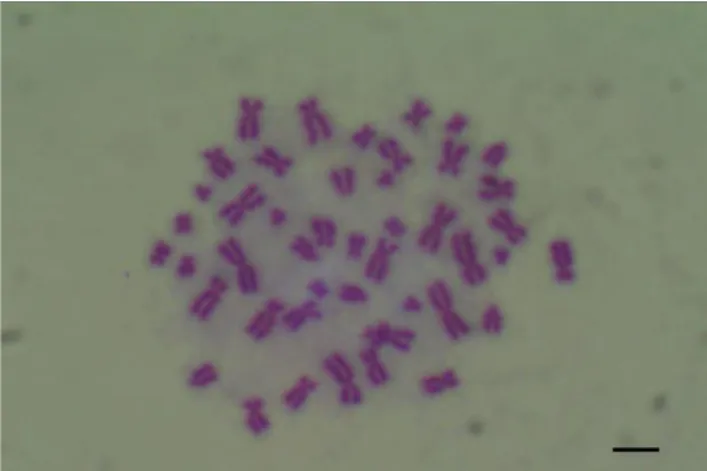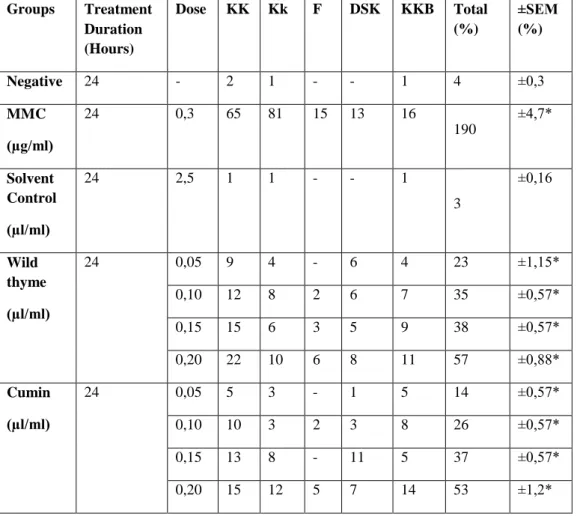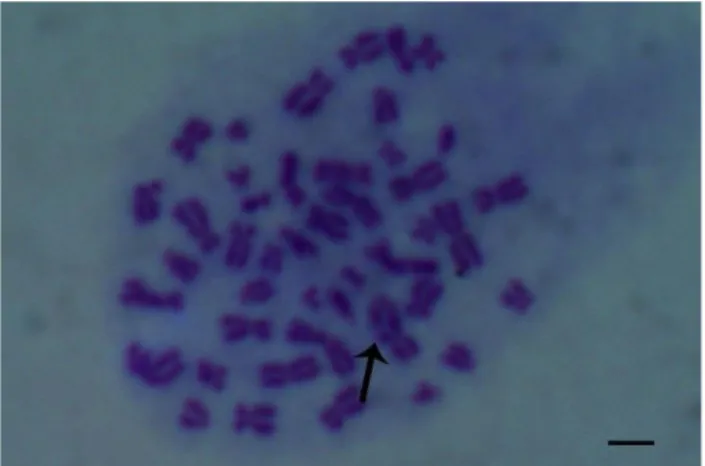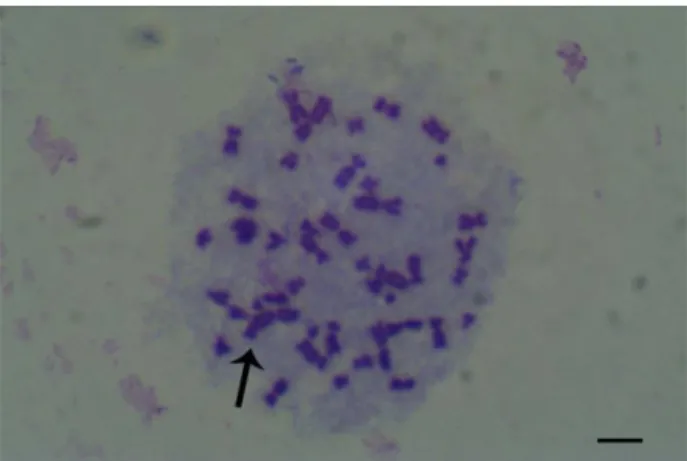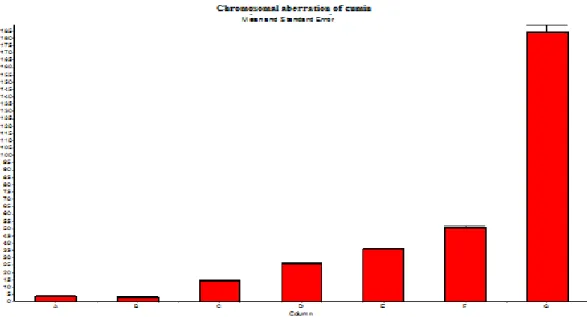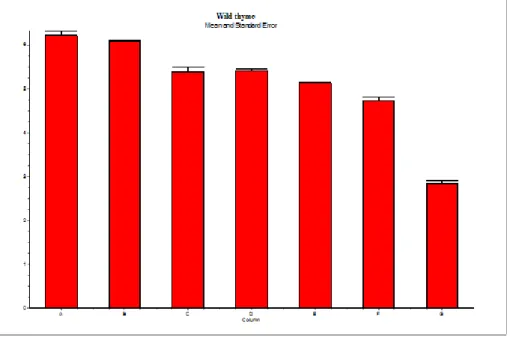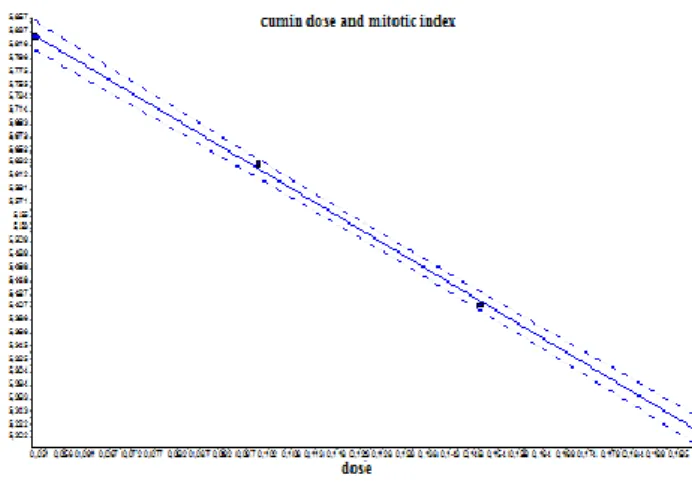Abstract
The aim of this study was to investigate the genotoxic and cytotoxic effects of essential oils of T.spicata and C. cyminum on human peripheral blood lymphocytes. Human peripheral blood lymphocyte cells were treated with 0.05μl/ml, 0.10μl/ml, 0.15μl/ml, 0.20μl/ml concentrations of essential oils of T.spicata and C. cyminum for 24 h. A significant increase was observed for induction of chromosomal aberration frequency in all treatments of essential oils of T.spicata and C. Cyminum concentrations for 24 h comparing with the negative control and mitomycin C (MMC, 0.3µg/ml) which was used as positive control. Chromatid and chromosome breaks, sister chromatid union, fragment and chromatid exchange were observed in all treatment concentrations. Essential oils of T.spicata and C. Cyminum decreased the mitotic index (MI) in all the concentrations and treatment times when compared with control and solvent control. Our results suggest that essential oils of T.spicata and C. cyminum have clastogenic potential for human lymphocytes chromosomes in-vitro.
Keywords: T.spicata, C. cyminum, mitomycin C (MMC), lymphocyte cultures, human chromosomes, chromosome aberrations, mitotic index.
1. Introduction
In the studies it was shown that genotoxic activity of some essential oils and components thereof was occurred in parallel with a certain dose increase (MILLARD, 1973; SHAH et al. 1996). Toxicity which occurs as a result of interaction of toxic agents with DNA molecules and which is transferred to the next generation is defined as “genotoxicity”. Genotoxic effect may occur by methylation, or mutations caused directly by the agents (GULEY and VURAL 1975).
Accepted date: 18.11.2015 Corresponding author: Selvinaz Yakan, PhD
Ağrı İbrahim Çeçen University, Eleşkirt Celal Oruç School of Animal Production,
Department of Animal Health, Ağrı, Turkey E-mail: syakan@gmail.com
Genotoxicity tests may be at a molecular and chromosome level. In the genotoxicity studies at the chromosome level, Sister Chromatid Exchange (SCE), Chromosomal aberrations (CA) and Micronucleus (MN) analysis methods are often used (KLAASSEN et al. 2001). Chromatid/chromosome breaks, aberrant unions, chromosomal aberrations as well as numerical abnormalities of chromosome such as aneuploidy and polyploidy may be determined via a test system. This test method is applied to search the clastogenic effect (SAVAGE, 1999; TUYLU, 2001). Changes in chromosome structure and number are called chromosomal aberrations. This occurs spontaneously, or as a result of chemical/radiation treatment (RUSSELL, 2002). Chromosomal aberrations arise from destruction at DNA level and can be caused by non-repair or mis-repair of double strand DNA breaks (ILIAKIS et al., 2004). It was detected that some compounds contained in essential oils obtained from plants had cytotoxic, mutagenic or anti-mutagenic effects (ELIANA et al., 2002; MURUGAN et al., 2007).
As a result of literature review, it was discovered that effects of wild thyme (T. spicata) and cumin (T. spicata) on chromosomal aberrations have not been studied. The object of this study is to detect effects of essential oils of wild thyme and cumin which are commonly used by people on formation of chromosomal aberration (CA) in human peripheral blood lymphocytes in vitro.
2. Material and Methods
*This study was approved by Ethical Committee of Medicine Faculty of Kafkas University with Approval No. 29.06.2011/ 06.
In this study, essential oils of C. cyminum and T. spicata were used as a study material. Peripheral blood collected from 10 healthy men (22-25 years old) and 10 healthy women (between 22-25 years old) who were nonsmokers and took no drug routinely was transferred to a blood medium. Essential oils of C. cyminum and T. spicata were used as a study material in this study.
Investigation of effects of essential oils of Cumin (cuminum cyminum) and Wild Thyme
(thymbra spicata) on human lymphocyte chromosomes
YAĞMUR YILDIZ1, SÜLEYMAN GÜL1, SELVİNAZ YAKAN2
1Kafkas University, Faculty of Science and Letters, Department of Molecular Biology and Genetics, Kars, Turkey 2Ağrı İbrahim Çeçen University, Eleşkirt Celal Oruç School of Animal Production, Department of Animal Health, Ağrı, Turkey
Wild thyme and cumin were subjected to water steam distillation using a Non-Asbestos Clevenger device for 3.5-4 hours by placing 40 gr of plant and 400 ml of water in a 500 ml volumetric flask. After 4 hours the obtained essential oil was transferred to a collection container and stored at +4°C for use in the study.
Mitomycin-C (MMC)
Mitomycin C was obtained from Sigma and used as a positive control in the study.
0.6 mg of mitomycin was weighted, dissolved in distilled water and the volume was brought to 1.5 ml.
Chromosome Medium (Medium)
Chromosome Medium B produced by Biochrom was used as a cell culture in the study.
Producing the Cell Culture, Making and Staining Preparations to Detect Chromosomal Aberrations
Producing the Cell Culture and Making Preparations
Peripheral blood collected from 10 healthy men and 10 healthy women with an age range of 22-25 years old who are nonsmokers and took no drug routinely was used. 10-12 drops of heparinized blood samples taken at a ratio of 1/10 were sterile-placed in chromosome mediums (5 ml per tube). The cell culture was incubated in an oven at 37 °C for 72 hours.
Negative Control Group
It was maintained as a negative control group. It was added to the test tubes as a medium (12 drops of blood + 5 ml of medium). No addition was done for control group. It was performed for two experiment groups. Incubation of 72 hours was performed.
Positive Control Group
It was maintained as a positive control group. 0,3 µg/ml of Mitomycin-C (MMC) was added to the test tubes as a medium (12 drops of blood + 5 ml of medium). In the last 24 hours of incubation (72-hour incubation) MMC was added (i.e. added 48 hours after it was left to incubation). It was performed for two experiment groups.
Solvent control Group (Acetone)
For solvent control 2.5 µl/ml of acetone was added to the test tubes as a medium (12 drops of blood + 5 ml of medium). In the last 24 hours of incubation (72-hour incubation) acetone was added (i.e. added 48 hours after it was left to incubation). It was performed separately for two experiment groups.
Experiment 1: Essential oil of T. Spicata
Group 1. 0.05 µl/ml of stock prepared for essential oil of wild thyme was added to the test tubes as a medium (12 drops of blood + 5 ml of medium). In the last 24 hours of incubation (72-hour incubation) essential oil of wild thyme was added (i.e. added 48 hours after it was left to incubation).
Group 2. 0.10 µl/ml of stock prepared for essential oil of wild thyme was added to the test tubes as a medium (12 drops of blood + 5 ml of medium). In the last 24 hours of incubation (72-hour incubation) essential oil of wild thyme was added (i.e. added 48 hours after it was left to incubation).
Group 3. 0.15 µl/ml of stock prepared for essential oil of wild thyme was added to the test tubes as a medium (12 drops of blood + 5 ml of medium). In the last 24 hours of incubation (72-hour incubation) essential oil of wild thyme was added (i.e. added 48 hours after it was left to incubation).
Group 4. 0.20 µl/ml of stock prepared for essential oil of wild thyme was added to the test tubes as a medium (12 drops of blood + 5 ml of medium). In the last 24 hours of incubation (72-hour incubation) essential oil of wild thyme was added (i.e. added 48 hours after it was left to incubation).
Experiment 2: Essential oil of C. cyminum
Group 1. 0.05 µl/ml of stock prepared for essential oil of cumin was added to the test tubes as a medium (12 drops of blood + 5 ml of medium). In the last 24 hours of incubation (72-hour incubation) essential oil of cumin was added (i.e. added 48 hours after it was left to incubation). Group 2. 0.10 µl/ml of stock prepared for essential oil of cumin was added to the test tubes as a medium (12 drops of blood + 5 ml of medium). In the last 24 hours of incubation (72-hour incubation) essential oil of cumin was added (i.e. added 48 hours after it was left to incubation). Group 3. 0.15 µl/ml of stock prepared for essential oil of cumin was added to the test tubes as a medium (12 drops of blood + 5 ml of medium). In the last 24 hours of incubation (72-hour incubation) essential oil of cumin was added (i.e. added 48 hours after it was left to incubation). Group 4. 0.20 µl/ml of stock prepared for essential oil of cumin was added to the test tubes as a medium (12 drops of blood + 5 ml of medium). In the last 24 hours of incubation (72-hour incubation) essential oil of cumin was added (i.e. added 48 hours after it was left to incubation).
In the last 2 hours of culture (at 70 hours of culture) 40 µl of colchicine solution was added to each tube (0.06 µg colchicine/ml medium) and the tubes were mixed. The cells were treated with colchicine for 2 hours. In the end
of culture (at 72 hours) the culture tubes were centrifuged at 2000 rpm for 10 minutes and the supernatant was discarded. 5 ml of hypotonic stored in an oven at 37°C was added dropwise after 0.5-0.7 ml of bottom liquid containing the cells was mixed. The tubes were sealed and placed in an oven. The cells were left in hypotonic in the oven at 37°C for 30 minutes. At the end, the tubes were centrifuged at 2000 rpm for 10 minutes and the supernatant was discarded. Cold fixative was slowly added with shaking and the volume was brought to 5 ml. The tubes were centrifuged at 2000 rpm for 10 minutes at room temperature and the supernatant was discarded. Again, the fixative was added and this procedure was repeated for 3 times. After the last centrifugation the supernatant was discarded such that 0.5-0.7 mf of liquid was left at the bottom of the tube. The bottom cells were homogenized by mixing via a Pasteur pipette. 4-5 drops of cell solution was drawn to Pasteur pipette and 3 drops of the solution were dropped to each slide from a height of 50 cm. During dropping it was allowed that drops were applied to different areas on the slide. Thus, overlapping of cells was avoided. Preparations were dried at room temperature for 24 hours (GUL et al. 2012; GUL et al. 2009).
Preparation Staining and Making Permanent Preparations
Preparations dried at room temperature were stained with 10% Giemsa stain solution. Dried preparations were placed in stain and kept therein for 10 minutes. Preparations removed from stain were washed with pure water contained in three separate containers to remove excess stain. Preparations were dried vertically. Dried preparations were mounted with entellan to make them permanent. They were examined with microscopy after entellan was dried.
Microscopic examination
Permanent preparations were examined with an immersion objective using an Olympus binocular light microscope (at 10x100=1000 magnification). In order to determine chromatid/chromosome break, chromatid union, fragment, etc., from the preparations having well-distributed chromosomes a microscopic examination was performed by counting 100 metaphases. Abnormalities formed in these cells were recorded and percentage values thereof were calculated. The observed chromosome structure and the number abnormalities were evaluated and denominated according to International System for Human Cytogenetic Nomenclature (ISCN) (PAZ-Y-MINO et al. 2002).
Mitotic Index (MI) Detection
Three thousand cells out of preparations of each group were examined and among them the cells which were in metaphase were detected and recorded. Metaphase rates observed in these three thousand cells were calculated as percentage and the mitotic index was calculated.
Taking Photo with a Microscope
Photos were taken with an Olympus microscope at 1000X magnification. Photos of CA samples were taken.
Statistical Analysis and Evaluation of Results The statistical analyses were done using Windows 95 GraphPad Instat 3.05 (GraphPad Software, San Diego California USA). Detection of the difference between the experiment groups and the negative controls was achieved using a Dunnet t-test. Regression and correlation analyses were performed to determine dose-effect relation. Regression equation and correlation coefficient (r) were found and a regression line was plotted.
3. Results
A chromosome image belonging to a normal, healthy individual was provided in Figure 1 and Figure 2. Chromosomes were firstly contacted with MMC used as a positive (0.3 µg/ml). It was observed that mitomycin-C led to damages in the chromosome such as chromosome and chromatid breaks, fragment, dicentric chromosome and sister chromatid unions.
Figure 1. Chromosome image from a normal, healthy individual, 24-hour treatment (x1000)
Aberration ratios in human lymphocyte culture chromosomes contacted with variable doses of control and experiment groups were provided in Table 1 (Tukey Test). It was detected that there was no significant increase when solvent control was compared to the control group. The applied doses of wild thyme (0,05 µl/ml, 0,10 µl/ml, 0,15 µl/ml, 0,20 µl/ml) were caused an increase in frequency of
chromosomal aberration statistically when all experiment groups treated with an essential oil of Wild thyme were compared to the negative control and the positive control, mitomycin-C (MMC, 0.3 μg/ml) (Figure 10).
The results of the study indicate that wild thyme has an in vitro clastogenic potential on human lymphocyte chromosomes.
Table 1. Aberration ratios in human lymphocyte culture chromosomes contacted with variable doses of experiment groups and control.
Groups Treatment Duration (Hours) Dose KK Kk F DSK KKB Total (%) ±SEM (%) Negative 24 - 2 1 - - 1 4 ±0,3 MMC (µg/ml) 24 0,3 65 81 15 13 16 190 ±4,7* Solvent Control (µl/ml) 24 2,5 1 1 - - 1 3 ±0,16 Wild thyme (µl/ml) 24 0,05 9 4 - 6 4 23 ±1,15* 0,10 12 8 2 6 7 35 ±0,57* 0,15 15 6 3 5 9 38 ±0,57* 0,20 22 10 6 8 11 57 ±0,88* Cumin (µl/ml) 24 0,05 5 3 - 1 5 14 ±0,57* 0,10 10 3 2 3 8 26 ±0,57* 0,15 13 8 - 11 5 37 ±0,57* 0,20 15 12 5 7 14 53 ±1,2*
Chromosome and chromatid breaks, sister chromatid unions, fragment and dicentric chromosomes were observed in all dose applications. Wild thyme decreased the cell division index (MI) at all concentrations when compared to the negative and solvent control (Figure 12). In other words, wild thyme induced the formation of chromosomal aberration. However this increase was not as high as in MMC which was used as a positive control.
It was shown in Figure 11 that the applied cumin essential oil (0,05 µl/ml, 0,10 µl/ml, 0,15 µl/ml, 0,20 µl/ml) was caused an increase in frequency of chromosomal aberration statistically when all experiment groups treated with cumin were compared to the negative control and the positive control, mitomycin-C (MMC, 0.3 μg/ml) (Figure 10). Chromosome and chromatid breaks, sister chromatid unions, fragment and dicentric
chromosomes were observed in all dose applications. Cumin essential oil decreased the cell division index (MI) at all concentrations when compared to the negative and solvent control (Figure 13). The results of the study indicate that cumin essential oil has an in vitro clastogenic potential on human lymphocyte chromosomes. In other words, cumin essential oil induced the formation of aberration. However this increase was not as high as in MMC which was used as a positive control.
KK: Chromosome break, Kk: Chromatid break, F: Fragment, DSK: dicentric chromosome KKB: sister chromatid union MMC: (0.3 µg/ml mitomycin-C (24 hours).
p>0.05 means that difference between control and solvent control is not statistically significant
* p< 0.01 means that difference is statistically significant when compared to the control (according to Tukey test).
Chromosome break (Figure 3 and Figure 4), chromatid break (Figure 3, Figure 5 and Figure 7), dicentric chromosome (DSK, Figure 8, Figure 9), fragment (Figure 5), sister chromatid union (KKB) (Figure 6 and Figure 8) in the experiment groups treated with wild thyme and cumin in human lymphocyte culture were shown.
Figure 2. Chromosome image treated with solvent control (acetone), 24-hour treatment (x1000)
Figure 3. Chromosome break (KK) (a), Chromatid break (Kk) (b), 24-hour treatment (x1000).
Figure 4. Chromosome break (KK), 24-hour treatment (x1000).
Figure 5. Chromatid break (Kk) (a), Fragment (F), (b), 24-hour treatment (x1000).
Figure 6. Sister chromatid union (KKB), 24-hour treatment (x1000).
Figure 7. Chromatid break (Kk), 24-hour treatment (x1000).
Figure 8. Dicentric chromosome (DSK) (a), Sister Chromatid Union (KKB) (b) 24-hour treatment (x1000).
p>0.05 means that difference between the negative
control and solvent control is not significant * p<
0.01 means that difference is significant when
compared to the control (Dunnett t-test)
Figure 9. Dicentric chromosome (DSK), 24-hour treatment (x1000).
In Figure 10 and Figure 11 aberration ratios of the chromosome contacted with variable doses of wild thyme (0,05 µl/ml, 0,10 µl/ml, 0,15 µl/ml, 0,20 µl/m) and with variable doses of cumin (0,05 µl/ml, 0,10 µl/ml, 0,15 µl/ml, 0,20 µl/ml) in human lymphocyte culture were shown.
Figure 10. Chromosomal aberration ratios in human lymphocyte culture contacted with variable doses of wild thyme (0,05 µl/ml, 0,10 µl/ml, 0,15 µl/ml, 0,20 µl/ml) (A: Negative Control, B: solvent control, C: 0.05µl/ml of wild thyme, D: 0.10µl/ml of wild thyme, E: 0.15µl/ml of wild thyme, F: 0.20µl/ml of wild thyme, G: MMC)
Effects of wild thyme and cumin which are used in human lymphocyte culture experiments on mitotic index are provided in Table 2 and Table 3.
For mitotic index ratios of wild thyme, difference between the negative control and solvent control was not significant (p>0.05) whereas this difference was significant (* p< 0.01) when all doses were compared to the control (Dunnet t-test).
All doses were compared to the negative and positive control (Figure 12). Regression line between varying concentrations of wild thyme and mitotic index was plotted (Figure 14). A negative correlation was found between varying concentrations of wild thyme and mitotic index (r= -0.99).
As shown in Tables and Figures, rate of chromosome breaks and other aberrations increases with increasing doses of essential oils of wild thyme and cumin whereas a dosedependent decrease is seen for mitotic index (r= -0.99).
4. Discussion
Essential oils have some side effects (SARER et al. 1991; LEAL-CARDOSO and FONTELES 1999). The most dangerous effects of these substances are their possible risk of causing mutations and cancers. In addition to use of plants for medical purposes, it is extremely important to reveal that they do not cause mutations in human genome (ALBERTINI et al. 2000).
AZIRAK, S. tried to detect that whether aroma chemicals (thymol and carvacrol) of essential oil of T. spicata increased chromosomal abnormalities in rat bone marrow cells in vivo and had a genotoxic risk for living creatures. As a result, AZIRAK, S. concluded that thymol and carvacrol decreased the cell division and exhibited cytotoxic effects as they suppressed ATP production in rat bone marrow cells in vivo, or because of their genotoxic effects (AZIRAK 2007).
For mitotic index ratios of cumin, difference between the negative control and solvent control was not significant (p>0.05) whereas this difference was significant (* p< 0.01) when all doses were compared to the control (Dunnet t-test). All doses were compared to the negative and positive control (Figure 13).
Regression line between varying concentrations of wild thyme and mitotic index was plotted (Figure 15). A negative correlation was found between varying concentrations of cumin and mitotic index (r= -0.99). p>0.05 means that difference between the negative control and solvent control is not significant
Dorman et al., reported that T. spicata extract didn’t have an antioxidant effect (DORMAN et al. 2004).
Stammati et al., reported that aerochemicals of T. spicata, thymol and carvacrol, had a mutagenic effect in Ames test (STAMMATI et al. 1999).
In another study Azizan and Blevins reported that thymol did not have any mutagenic or anti-mutagenic effect (AZIZAN and BLEVINS 1995).
Aydın et al., examined the genotoxic effects of thyme oil extracts with methanol in human lymphocytes using a single cell gel electrophoresis whereas they examined the protective effect of thyme oil on DNA in the presence of IQ (2-amino-3-methylimidazo [4,5-f]-quinoline) and MMC. They detected that thyme oil did not cause DNA breaks at lower concentrations whereas it damaged DNA seriously at higher concentrations. Moreover, they determined that lower concentrations of thyme oil reduced DNA damages caused by IQ and MMC (AYDIN et al. 2005).
Figure 11. Chromosomal aberration ratios in human lymphocyte culture contacted with variable doses of cumin (0,05 µl/ml, 0,10 µl/ml, 0,15 µl/ml, 0,20 µl/ml) (A: Negative Control, B: solvent control, C: 0.05 Cumin, D: 0.10 of cumin E: 0.15 of cumin F:0.20 of cumin, G: MMC).
Table 2. Mitotic Activity Ratios in Human Lymphocyte Culture Contacted With Varying Doses of Wild Thyme and Control Groups Treatment Duration (Hours) Total Cell Cell number in metaphase Mitotic Index (24 hours) (%) ±SEM(%) Negative control 24 3000 188 6.14 ± 0.09 181 Positive Control MMC(0.3 µg/ml) 24 3000 82 2.71 ±0.08* 81 Wild thyme (0.05 µl/ml) 24 3000 168 5.55 ±0.10* 165 Wild thyme (0.10 µl/ml) 24 3000 160 5.31 ±0.05* 159 Wild thyme (0.15 µl/ml) 24 3000 153 5.08 ±0.03* 152 Wild thyme (0.20 µl/ml) 24 3000 148 4.88 ±0.08* 145 Solvent control (acetone) (2.5 µl/ml) 24 3000 182 6.04 ±0.02
180
* p< 0.01 means that difference is significant when compared to the control (Dunnett t-test)
Figure 12. Mitotic index ratios in human lymphocyte culture contacted with variable doses of wild thyme (0.05 µl/ml, 0.10 µl/ml, 0.15 µl/ml, 0.20 µl/ml ) (A: Negative Control, B: solvent control, C: 0.05µl/ml of wild thyme, D: 0.10µl/ml of wild thyme, E: 0.15µl/ml of wild thyme, F: 0.20µl/ml of wild thyme, G: MMC)
Figure 13. Mitotic index ratios in human lymphocyte culture contacted with variable doses of cumin (0.05 µl/ml, 0.10 µl/ml, 0.15 µl/ml, 0.20 µl/ml) (A: Negative Control, B: solvent control, C: 0.05 µl/ml of Cumin, D: 0.10 µl/ml of cumin E: 0.15 µl/ml of cumin F:0.20 µl/ml of cumin, G: MMC)
Table 3. Mitotic Activity Ratios in Human Lymphocyte Culture Contacted with Varying Doses of Cumin and Control
Groups Treatment Duration (Hours) Total Cell Cell number in metaphase Mitotic Index (24 hours) (%) ±SEM(%) Negative control 24 3000 188 6.14 ±0.090 181 Positive Control MMC(0.3 µg/ml) 24 3000 82 2.71 ±0.060* 81 Cumin (0.05 µl/ml) 24 3000 176 5.83 ±0.050* 174 Cumin (0.10 µl/ml) 24 3000 171 5.63 ±0.030* 167 Cumin (0.15 µl/ml) 24 3000 163 5.41 ±0.010* 162 Cumin (0.20 µl/ml) 24 3000 159 5.21 ±0.040* 154 Solvent control (acetone) (2.5 µl/ml) 24 3000 185 6.10 ±0.006
181
Figure 14. Regression (r= -0.99) graph between varying concentrations of wild thyme and mitotic index
Figure 15. Regression (r= -0.99) graph between varying concentrations of cumin and mitotic index Al-Batina et al. reported that essential oil of cumin used as a spice caused poor oxidative mutagenic activation on TA97a, TA98, TA100 and TA102 strains of Salmonella typhimurium (AL-BATAINA et al. 2003).
As a result of literature reviews, the results obtained from in vivo and in vitro studies with thymol and carvacrol which are active ingredients of T. Spicata (AZIRAK S. [95] and STAMMATI et al. [97]) correspond to our results.
It can be emphasized that the excessive concentrations should be avoided when using these plants. In addition, T. spicata and C. cyminum harbor a plurality of active ingredient in chemical structure thereof.
It should not be ruled out that which active ingredients cause those genotoxic effects exhibited by these species, or that this genotoxic effect may be occurred by an interaction between the active ingredients.
Isolating the active ingredients of these plants and subjecting them to the cytogenetic tests separately may
provide information relating to the ingredient or ingredients revealing cytogenetic effects of these species. The genotoxic features may be caused by synergistic effects of one or more than one ingredient contained in chemical structure of T. spicata and C. Cyminum. This provides new research subjects for further studies.
As a result, with in vitro treatment of essential oils of T. spicata and C. cyminum which are used in traditional folk medicine and as a spice with 4 different doses (0.05, 0.10, 0.15, 0.20 µl/ml) in human lymphocyte culture it was detected that:
1) essential oils of T. spicata and C. cyminum reduced MI and a negative correlation was found between MI and varying concentrations of wild thyme (r= -0.99) whereas similarly a negative correlation was found between MI and varying concentrations of cumin (r= -0.99);
2) a mitotic index of 6,14 in the negative control was decreased to 4,88 for the maximum dose of wild thyme while it was decreased to 5,21 for the maximum dose of cumin and thus, these two plants suppressed the cell division at applied doses; and
3) these two plants increased chromosomal aberrations depending on the dose when compared to the negative control.
REFERENCES
AL-BATAINA, B.A., MASSALAT, A.O., AL-KOFAHI, M.M. (2003), Element analysis and biological studies on ten oriental spices using XRF and Ames test, J. Trace Elem, Med. Biol., 17 (2), 85-90.
ALBERTINI, R.J., ANDERSON, D., DOUGLAS, G.R., HAGMAR, L. (2000), IPCS guidelines for the monitoring of genotoxic effects of carcinogens in humans. International Programme on Chemical Safety, Mutat. Res., s463, s72-s111.
AYDIN, S., BASARAN, A.A., BASARAN, N. (2005), The effects of thyme volatiles on the induction of DNA damage by the heterocyclic amine IQ and mitomycin C. Mutat Res 581(1-2): 43-53. AZIRAK, S. (2007). Thymol ve Carvacrol’un İn Vivo
Genotoksik Etkilerinin Araştırılması, PhD Thesis, Çukurova Üniversitesi, Fen Bilimleri Enstitüsü. AZIZAN, A., and BLEVINS, R.D. (1995), Mutagenicity
and antimutagenicity testing of six chemicals associated with the pungent properties of spesific spices as revealed by the Ames Salmonella/microsomal assay. Arch Environ ContamToxicol. 28 (2), 248-58.
DORMAN, H.J.D., BACHMAYER O., KOSAR M., HILTUNEN R. (2004), Antioxidant properties of aqueous extracts from selected lamiaceae species grown in Turkey, J Agric Food Chem. (4), 762-770.
VARANDA, E.A., POZETTI, G.L., LOURENCO, M.V., VILEGAS, W., RADDI, M.S.G. (2002), Genotoxicity of Brosimum gaudichaudii measured by the Salmonella/microsome assay and chromosomal aberrations in CHO cells. J Ethnopharm. 81 (2): 257-264.
GUL, S., DEMIRCI, B., BASER., K.H.C., AKPULAT, H.A., AKSU, P. (2012), Chemical Composition and In Vitro Cytotoxic, Genotoxic Effects of Essential Oil from Urtica dioica L. Bull Environ Contam Tox. 88(5): 666-671.
GUL, S., SAVSAR, A., TAYFA, Z. (2009), Cytotoxic and genotoxic effects of sodium hypochlorite on human peripheral lymphocytes in vitro. Cytotechnology 59(2): 113-119.
GULEY, M., and VURAL, N. (1975), Toksikoloji Laboratuvar Kitabı, ISBN: 975-482-289-1, Ankara Eczacılık Fakültesi Yayınları, Ankara. KLAASSEN, C.D. (2001), Casarett and Doull's
Toxicology: The Basic Science of Poisons, (6th ed.), New York, McGraw-Hill.
LEAL-CARDOSO, J.H., and FONTELES, M.C. (1999), Pharmacological effects of essential oils of plants of the northeast of Brazil. An Acad Bras Cienc. 71: 207-213.
MILLARD, L.G. (1973), Contact sensitivity to toothpaste, Br. Med. J. 1 (5854): 676-676.
MURUGAN, S.S., BALAKRISHNAMURTHY, P., MATHEW, Y.J. (2007), Antimutagenic effect of broccoli flower head by the Ames Salmonella reverse mutation assay. Phytotherapy Research 21 (6): 545-547.
PAZ-Y-MINO, C., BUSTAMANT, E.G., SANCHEZ, M.E., LEONE, P.E. (2002), Cytogenetic monitoring in a population occupationally exposed to pesticides in Ecuador. Environmental Health Perspectives 110 (11): 1077-1080. SAVAGE, J.R.K. (1999), An Introduction to
Chromosomal Aberrations. Atlas Genet Cytogenet Oncol Haematol .
SHAH, M., LEWIS, F.M., GAWKRODGER, D.J. (1996), Contact allergy in patients with oral symptoms: A study of 47 patients, Am. J. Contact Dermat., 7 (3):146-51
STAMMATI, A., BONSI, P., ZUCCO, F., MOEZELAAR, R., ALAKOMI, H.L., VON
WRIGHT, A. (1999), Toxicity of selected plant volatiles in microbial and mammalian short-term assays. Food Chem Toxicol 37 (8): 813-823. SARER, E. (1991), Uçucu Yağların Biyolojik Etkileri ve
Tedavide Kullanımları, 9. Bitkisel İlaç Hammaddeleri Toplantısı, Bildiriler Kitapçığı, Eskişehir.
TUYLU, B.A. (2001), Bazı ilaç öncül maddelerinin bakteriyal ve hücre kültürü yöntemleriyle araştırılması. PhD Thesis. Anadolu Üniversitesi Fen Bilimleri Enstitüsü. Eskişehir.
